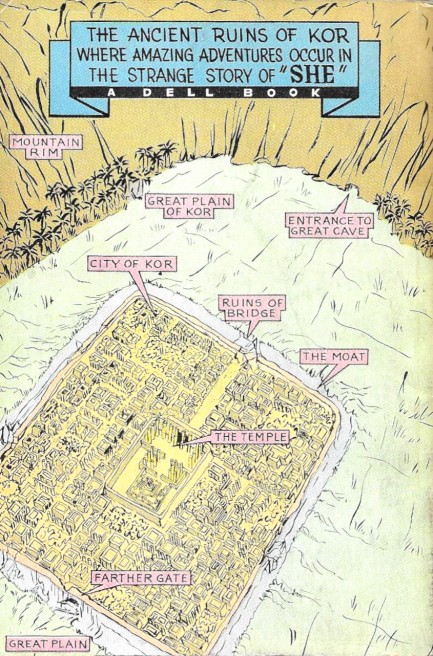 If you're in the fashion business—everything. 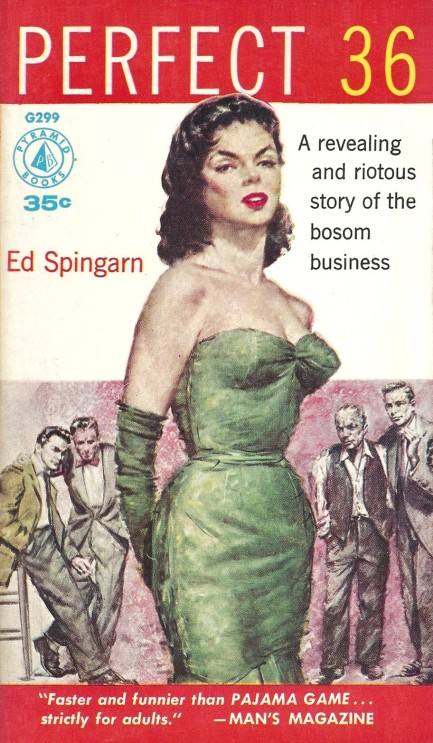
Ed Spingarn's NYC garment district tale Perfect 36 was first published in 1957 by Pyramid Books with cover art by Robert Maguire. In 1960 Pyramid re-issued the novel in the form above, giving Lou Marchetti a shot at the cover, and of course he did a nice job. This yarn (see what we did there?) was entertaining and different. Our detailed thoughts are here.
 Frankly, I've learned that the best therapy is to make a lot of money. That's why I'm a psychiatrist. 
Yes, we've found yet another therapy cover, Sim Albert's 1954 sleazer Woman-Crazy Doctor, for Croydon Books with Lou Marchetti art. These covers are so fun to riff on. We've done it multiple times, and you can see those posts by going to this link, and following the subsequent links in that entry. This is the second book from Albert we've read, after 1953's so-so Confessions of a B-Girl. Here he tells the story of a psychiatrist named Horton Foote who, in his desire to bed his beautiful patient Norma Strothman, hires her as his secretary. Surely that's against the Hippocratic oath. Do psychiatrists take the Hippocratic oath? *checking internet* Yes, they do. But oaths were made to be broken. Horton has other women he sees—hence “woman-crazy”—but Norma remains his overriding pursuit, and of course it wouldn't be a sleaze novel if he didn't succeed. Actually, the book could be called “Man-Crazy Patient,” because it's Norma's suddenly awakened sexual desires that drive the plot. She just can't get enough lovin'. Into this scenario Albert mixes manslaughter, concealment of a corpse, and attempted suicide, making the tale crime novel-adjacent. He even manages to occasionally interject genuinely affecting emotion. In short, we were surprised at his competence. So surprised, in fact, that if we can find another effort from him, he's earned another go-round.
 French toast, French doors, French kissing, and now French nursing. You people make an art out of everything. 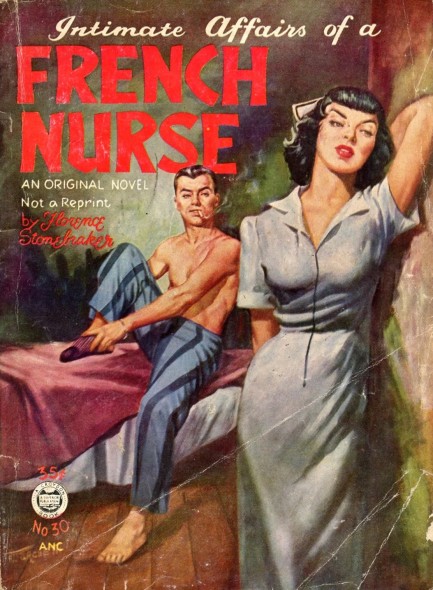 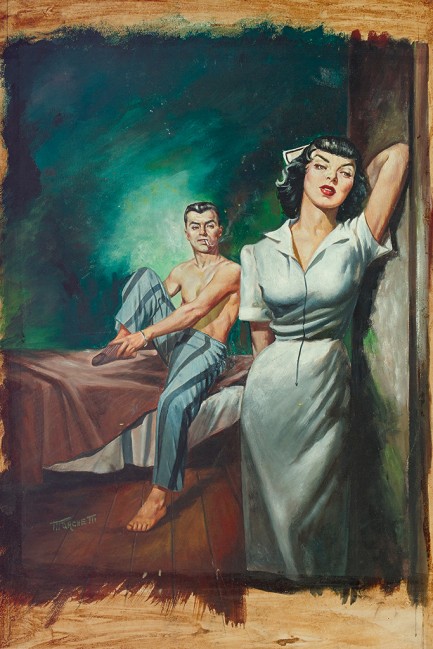
Above: a very nice cover plus textless original art painted by Lou Marchetti for Florence Stonebraker's 1954 sleaze digest Intimate Affairs of a French Nurse. There's a lot of Stonebraker out there on the auction sites (and in Pulp Intl.), but we consider all the ones that interest us to be a little too expensive. Fortunately, she wrote more than eighty novels, which means that, inevitably, something will turn up at a good price.
 Intelligent, thoughtful, scalding hot—what's the catch? 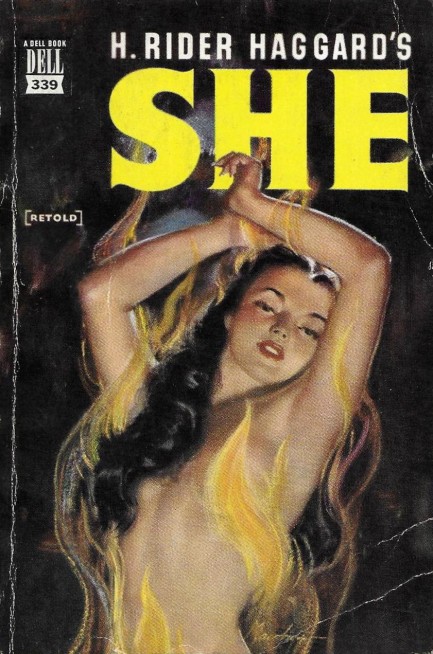
H. Rider Haggard's novel She is one of those rare fantasy/sci-fi novels that has been widely read through three different centuries. A pre-pulp novel, it was originally published in 1887, retained popular interest through the pulp era when it was made into a 1935 movie starring Helen Gahagan, continued generating interest through the mid-century paperback era and into the 1960s, when it was adapted with Ursula Andress in the lead role, and remains available in bookstores and from digital booksellers in the 2020s. The book has enjoyed such longevity because it's a well-written and archetypal lost world adventure with all the elements that sub-genre requires: intrepid explorers in an exotic land, savage encounters with locals, a central quest for something thought to be priceless or unobtainable, and a temptress at the center of the narrative.
The temptress, Ayesha, is an ancient but youthful countenanced woman of Arab descent who has discovered the secret to long life, but who's lost her true love along the way and awaits his reincarnation. She lives in a lost realm called Kôr amidst a host of Africans, who she hates, but rules while she pines for her dead lover to return. Two thousand years after his death, his direct descendant undertakes an expedition to the African interior, where he and Ayesha are destined to meet. This descendent, Leo Vincey, accompanied by his mentor and friend Horace Holly, has been handed down a story through the generations of an immortal woman who murdered his forebear. His quest is to find if such a fantastic story can be true, and possibly take revenge for his entire bloodline.
Haggard is good with descriptive passages, but what's equally interesting is that the book is partly procedural in nature, with long transcriptions of Latin, Arabic, and Greek, and an abundance of academic discussion. Eventually the tale centers around Ayesha's belief that Leo Vincey is her dead lover returned to her, which means her African vigil is mercifully at an end. Her plan? To go to England and rule it with Leo. She'll have to depose Queen Victoria to make that happen, but since she possesses advanced if not magical powers, she considers that no biggie. While we'd have loved to see the story head in that direction, obviously nothing written during the Victorian Age is going to involve a plot to destroy its eponymous figurehead. But what fun that would have been.
On a less fun note, and at risk of stating the obvious, books of this sort are culturally blinkered. The writers depict dark-skinned peoples as savage and deadly, though white-skinned peoples had by then ravaged the entire world, killing hundreds of millions upon hundreds of millions of people for no other reason than greed. This dismissal of non-white lives is exemplified when Horace Holly explains to Ayesha, who hates monarchs, that the nature of royalty has changed during the centuries of her self-imposed exile, and that Queen Victoria is, “venerated and beloved by all right-thinking people in her vast realms.” You have to smile at this, considering the British Empire was an industrial killing machine. Possibly Haggard wasn't aware of that back in 1887, but do any right-thinking people doubt he'd have ignored it even if he'd known?
It's a given that books such as She overlook or deliberately obscure these truths, therefore, if you crack one open, presumably you've made the decision to go along for the ride. While the book's cultural conceits will annoy some readers, it's worth noting that Ayesha's two thousand years of longevity provide Haggard the opportunity to espouse at least a few views unusual for the era, for example when she drops this nugget: “I have long seen that democracies, having no clear will of their own, in the end set up a tyrant and worship him.” Ayesha is Haggard's narrative savior, in our view. She's by far the most engaging character. Though he portrays her as ignorant due to her long sequestration, some of what she says is pretty damn insightful and ironic in 2023. It helps make She a little easier to swallow.
However, the flipside of Ayesha's sometimes intriguing opinions is that she's long-winded. You'd think two-thousand years of life would make her economical with words, but no—the woman can really beat a dead horse. Actually, so can Horace Holly, who narrates via a letter sent to a friend. These aren't dealbreaking flaws, merely ones to be forewarned about. They make the book many pages longer than it need be. And perhaps another small issue is that there aren't many surprises in the story—Holly's narration, being basically epistolary in nature, constantly hints at tragedy, and every plot turn makes a racket galloping at you from a great distance. But She is still good stuff from Haggard, and is a literary landmark for discernible reasons. This edition came from Dell Publications in 1949 with Lou Marchetti cover art.
 It's getting late, fellas. I really should be in bed with someone by now. 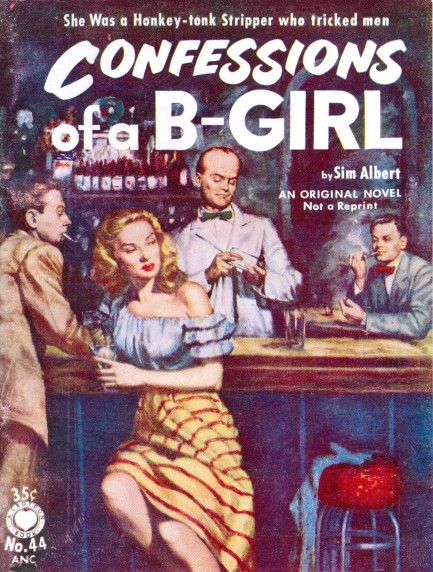
Sim Albert's 1953 Croydon Books novel Confessions of a B-Girl, which features cover art by Lou Marchetti, tells the story of a New Orleans stripper named Peg Christy who wants to get out of the racket before it turns her into a prostitute. She takes in a naive nineteen-year-old who's arrived in town penniless, and when the girl's hot uncle shows up Peg suddenly develops the courage to take a stab at reform and romance. Of course, she sort of forgets to tell uncle hunk she's a nightclub dancer, and that, along with the club owner's homicidal streak and her young roomie's assorted problems, provide the drama in the tale. Sleaze digests generally give you sex, misunderstanding, sex with the wrong guy, heartbreak, sex, and redemption, and Confessions of a B-Girl does basically that, but with less sex, and a dose of surrogate motherhood thrown in. It's no better than average quality for the genre, but we're glad we bought it because we're suckers for novels about burlesque dancers. Marchetti's art, by the way, fits nicely into our collection of bar covers, which you can see here.
 Some people wait for success to come. Some people go out and grab it. 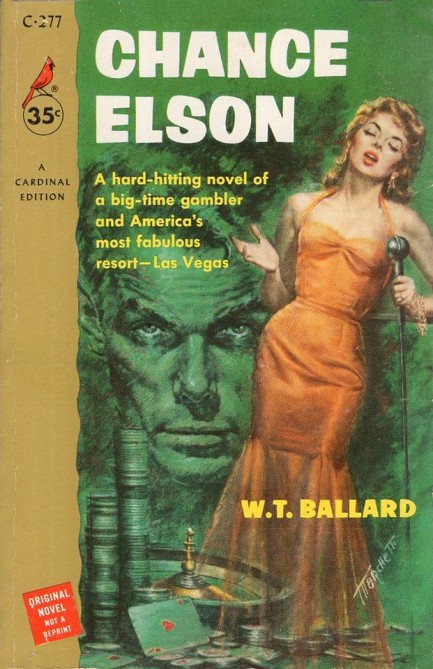
Lou Marchetti painted this cover for Chance Elson by W.T. Ballard, and as always does a good job. This came in 1958, and by then Ballard, who had been publishing since the days of Black Mask magazine, was an extremely experienced author. All that practice shows as he weaves the Depression-era tale of a Cleveland nightclub owner who's driven out of business and town by the mafia and crooked cops, fetches up way out west in a wasteland city called Las Vegas, and tries to build a hotel/casino empire. His rival in this endeavor turns out to be the same mafia thug who precipitated his departure from Cleveland.
There's an interesting subplot here involving Elson taking in an orphaned girl of fourteen named Judy, who grows into a beautiful woman and the main love interest. Because she had escaped from a reform school, he at first passes her off as his younger sister, but as she nears adulthood it's pretty clear to most that Woody and Soon-Yi—oops, we mean Chance and Judy—have something more than guardian/ward feelings for each other. As you might suspect, in the deadly game of dueling casinos that develops between Elson and the mafia, she becomes the pawn.
Chance Elson has a timeline that runs for over a decade, so the book moves beyond the boundaries of most crime thrillers into life story territory, and a major theme concerns whether Elson, who's trying to keep a growing Las Vegas from being overrun by organized crime, can win that battle without becoming as bad as those he seeks to thwart. Or more to the point, his business dealings hinge upon ruthlessness, but his personal dealings and opportunity for true love hinge upon becoming a better human being. Are there flaws in the book? Well, we weren't happy with certain aspects of the woman-in-danger subplot. But like we said, Ballard was experienced. His fictional retelling of the rise of Sin City is expert work.
 I'm pummeling you extra because I know when you tell the story later you'll say a man did it. 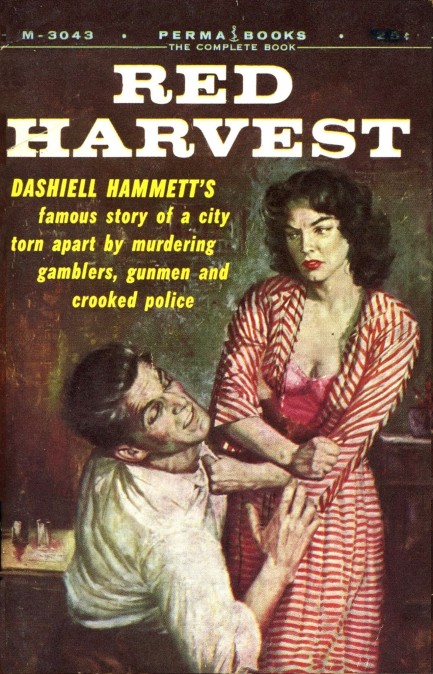
We already showed you a great 1958 Panther Books cover for Dashiell Hammett's 1929 debut novel Red Harvest. This cover comes from Perma and hit newsstands in 1956 with art by Lou Marchetti. We found it on Flickr. Hammett falls into that rare category of authors: a game changer. And this first book length effort from him is amazing. You can read a bit more about it here.
 Famed author Ian Fleming arrested after strangulation rampage at his publishing company. 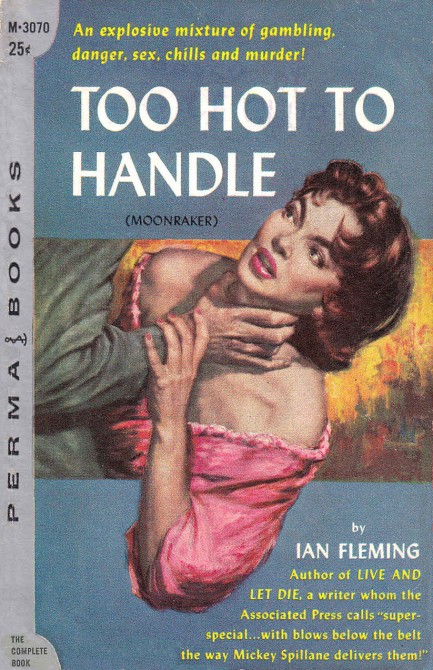
We talked about how Ian Fleming feuded with his publisher Perma Books over name changes to his James Bond novels. This is another one of the offending paperbacks, 1957's Too Hot To Handle. Not only had this book already been successfully published as Moonraker by the British hardback imprint Jonathan Cape, but the Lou Marchetti cover art Perma used doesn't fit the Bond brand at all. Signet Books did infinitely better when it got the rights in 1960. As far as Fleming trying to strangle everyone at Perma, we can't confirm that as fact. But we bet he thought about it.
 In the end she didn't think saying it with flowers would get her true feelings across. 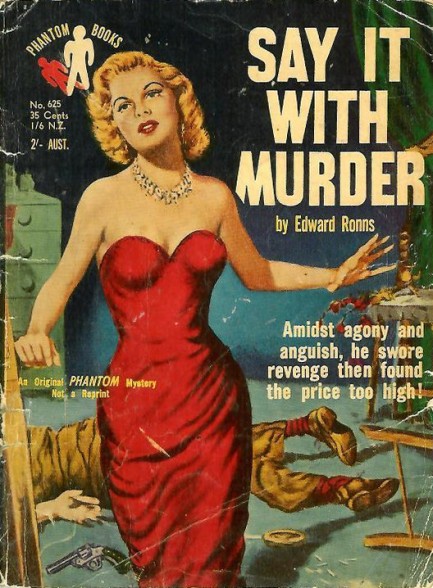
Tired of the rampant commercialism of Valentine's Day? So is the woman on the cover of Edward Ronns' 1955 thriller Say It with Murder. Too bad she doesn't live where we do, where there's no such holiday. This cover is from Australia's Phantom Books, a company we've been featuring often of late, and as we've mentioned, Phantom had a habit of using reconstituted art. You can see exactly what we mean by looking at the front of the 1954 Graphic Books edition, with its excellent work from Lou Marchetti. We still don't know exactly why Phantom changed its covers. A rights usage issue, we suppose. But if that's the case, why was the company able to get away with making near copies of the originals? We'll keep exploring this question until an answer presents itself.
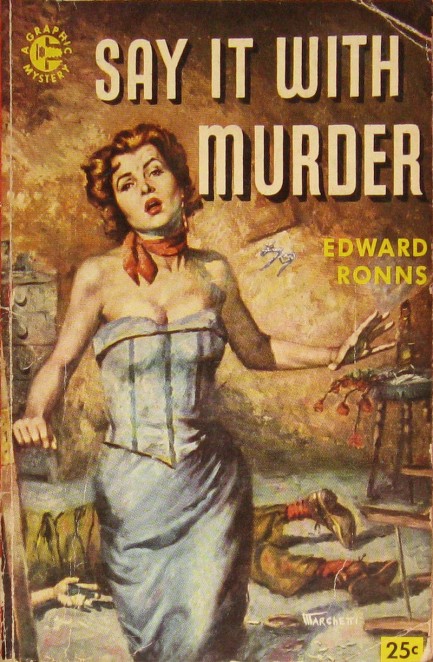
 He doesn't know what he's looking for in a woman. He just knows he'll find it eventually. 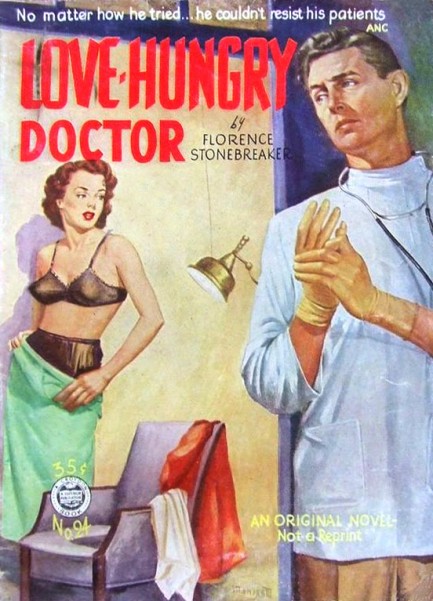
If you're thinking of writing a book but fear you're too late to start, take note: Florence Stonebraker published her first novel at age forty-one and went on to write more than eighty books. In 1952 alone she published eleven novels. True, her stuff was not literary fiction, but dollars are green no matter your audience, right? What's beyond doubt is that she is a well-regarded genre author and her books are collectible today. Love-Hungry Doctor came in 1953 and is exactly what it seems in the cover art by Lou Marchetti—an exploration of a shy doctor's romantic troubles, which are enlivened by the arrival of a new woman in his life. We've been doing a lot on Stonebraker lately, but it's because her books had the very best cover art of the era. Check what we mean with three more examples here, here, and here.

|
 |

The headlines that mattered yesteryear.
2003—Hope Dies
Film legend Bob Hope dies of pneumonia two months after celebrating his 100th birthday. 1945—Churchill Given the Sack
In spite of admiring Winston Churchill as a great wartime leader, Britons elect
Clement Attlee the nation's new prime minister in a sweeping victory for the Labour Party over the Conservatives. 1952—Evita Peron Dies
Eva Duarte de Peron, aka Evita, wife of the president of the Argentine Republic, dies from cancer at age 33. Evita had brought the working classes into a position of political power never witnessed before, but was hated by the nation's powerful military class. She is lain to rest in Milan, Italy in a secret grave under a nun's name, but is eventually returned to Argentina for reburial beside her husband in 1974. 1943—Mussolini Calls It Quits
Italian dictator Benito Mussolini steps down as head of the armed forces and the government. It soon becomes clear that Il Duce did not relinquish power voluntarily, but was forced to resign after former Fascist colleagues turned against him. He is later installed by Germany as leader of the Italian Social Republic in the north of the country, but is killed by partisans in 1945.
|

|
|

It's easy. We have an uploader that makes it a snap. Use it to submit your art, text, header, and subhead. Your post can be funny, serious, or anything in between, as long as it's vintage pulp. You'll get a byline and experience the fleeting pride of free authorship. We'll edit your post for typos, but the rest is up to you. Click here to give us your best shot.

|
|









